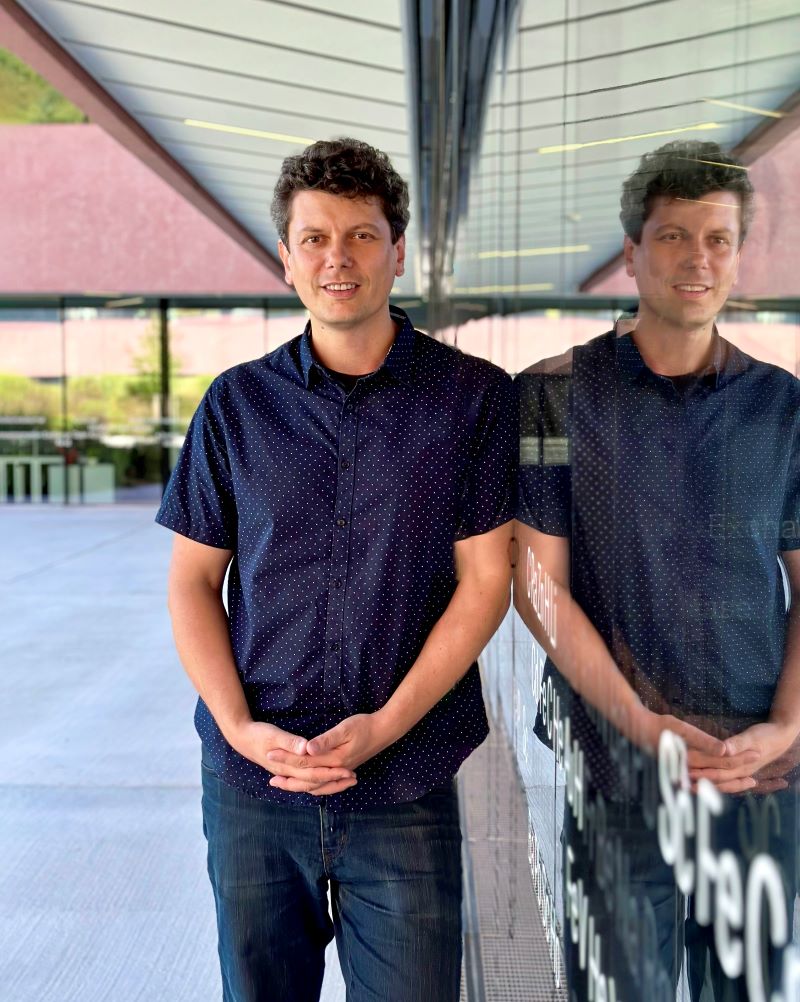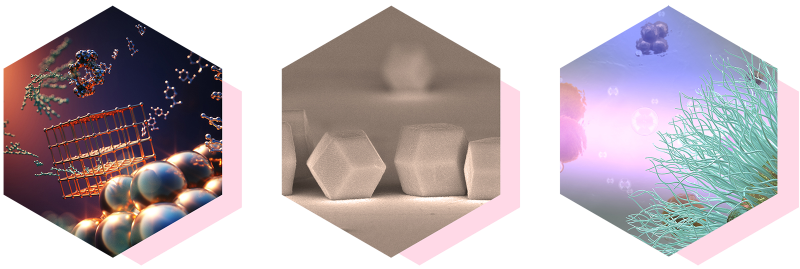November 2, 2023
New Professor Studying Supramolecular Chemistry
Chemist Rafal Klajn joins ISTA faculty
After 13 formative years at the Weizmann Institute of Science in Israel, Professor Rafal Klajn joined the faculty of the Institute of Science and Technology Austria (ISTA). His group focuses on supramolecular and colloidal chemistry. The arrival starts with a groundbreaking result: Science magazine recently published the group’s newest insights into molecules that can be switched to other states using colored light.

Nature has long impressed chemists with its ability to create complex structures and exquisite nanomaterials with unparalleled precision and efficiency. What natural systems consistently exploit is nanoscale confinement, which is fundamentally different from how chemists perform reactions. “I have been fascinated about this idea for a long time: as scientists, we deepen our understanding of nature”, says Klajn, “but we can also harness this understanding.” For the Klajn group, there are three principal questions.
Nanoconfinement and self-assembly
With his research group, Klajn investigates various aspects of supramolecular chemistry—a field that deals with molecules associating into larger “super-structures” with new, “emergent” properties.
The group’s first pillar is chemistry in confined spaces. They design and develop novel molecular ensembles and materials that contain nanoconfined environments and explore these environments for controlling chemical reactivities. “This approach has the potential to teach us innovative ways to perform chemical reactions”, believes Klajn, “ultimately paving the way to synthesizing unique nanostructures and nanomaterials.”
The second interest concerns the self-assembly of particles in the size range of 1 to 100 nanometers – less than 1/1000 of the width of a human hair. They study how nanoparticles interact. The group utilizes this knowledge to gain precise control of self-assembly to generate complex materials that may exhibit novel functionalities.
The third focus examines how sophisticated self-assembled structures—think of the complex supramolecular architectures that constitute living organisms—remain stable far from thermodynamic equilibrium. The group studies the design principles for such assemblies, particularly for systems that assemble in response to external stimuli such as light, magnetic fields, or chemical fuels. The newest Science paper exemplifies two of these pillars: It introduces a new confinement-based approach to broadening the spectrum of light that can be used to “switch” certain molecules. What does that mean?
A broadband photoswitch
Azobenzenes are the simplest and most widely studied photoswitchable molecules. Exposing them to ultraviolet (UV) light switches their configuration from the stable E (from the German entgegen) to the metastable, high-energy Z (zusammen) form. This process, called photoisomerization, is reversible: the back-isomerization from Z to E happens spontaneously within periods ranging from milliseconds to centuries, depending on the identity of azobenzene. Owing to the highly reversible nature of the photoswitching between E and Z, azobenzenes have found applications in energy storage systems, switchable catalysis, and photopharmocology. However, the necessity to rely on UV light has restricted their applicability.
The Klajn group now overcame this limitation following an inspiration from nature. Some deep-sea fish species developed a clever way to broaden the absorption range of their visual pigments in the course of evolution. The fish retinal, a visual pigment that derives its name from the retina, can co-opt another molecule to detect red light, almost like a kind of “antenna” that captures red light. This sensitizes the nearby retinal, whose isomerization triggers a sequence of events that ultimately leads to vision. The group’s new method uses a combination reminiscent of the natural antenna–retinal duo. It consists of an azobenzene and a visible dye, which acts as a photosensitizer. By co-confining it with an azobenzene, each dye “antenna” can turn hundreds of E-azobenzenes into the metastable Z form, thus converting the energy of visible light into chemical energy. Depending on the choice of the dye, the desired color of visible light—including red—can be used to drive the process.
“The process is, in principle, applicable to other classes of photoswitchable compounds,” comments Klajn on the potential ramifications of their results. “We envision that our method will become a powerful tool to control chemical reactivity through a combination of light and confinement.”

A path leading to ISTA
Born in Poland, Klajn received his early chemistry education in his hometown of Wrocław and later at the University of Warsaw. In 2009, he obtained a PhD in Chemical and Biological Engineering from Northwestern University, where he worked under the supervision of Prof. Bartosz A. Grzybowski. He then joined the Department for Organic Chemistry at the Weizmann Institute of Science, Israel, where he conducted research that led to numerous distinctions and awards. His work was recognized by awards from the American Chemical Society (ACS) and chemistry societies based in the Netherlands, Germany, Japan, and Israel. He has received two grants from the European Research Council (ERC Starting Grant 2013 and ERC Consolidator Grant 2018). He co-founded the Gordon Research Conference (GRC) series on Artificial Molecular Switches & Motors in 2015 and has recently co-chaired GRCs on Self-Assembly & Supramolecular Chemistry and Systems Chemistry.
At his arrival in 2023, Klajn is the sixth chemistry group leader at ISTA. “The conditions and opportunities provided here are simply outstanding. I am confident that with its rapidly expanding Chemistry faculty, ISTA will soon become recognized for its chemistry research and I am happy to be part of this journey. I am also excited to explore possible collaborations with my fabulous new colleagues.”
Publications:
New – Visible-light photoswitching of azobenzenes
- J. Gemen et al., Disequilibrating azobenzenes by visible-light sensitization under confinement, Science 2023, 381, 1357–1363. DOI: 10.1126/science.adh9059
Chemistry in confined spaces
- A. B. Grommet, M. Feller, and R. Klajn, Chemical reactivity under nanoconfinement, Nat. Nanotech. 2020, 15, 256–271. DOI: 10.1038/s41565-020-0652-2
- H. Zhao et al., Reversible trapping and reaction acceleration within dynamically self-assembling nanoflasks, Nat. Nanotech. 2016, 11, 82–88. DOI: 10.1038/nnano.2015.256
Self-assembly at the nanoscale
- T. Bian et al., Electrostatic co-assembly of nanoparticles with oppositely charged small molecules into static and dynamic superstructures, Nat. Chem. 2021, 13, 940–949. DOI: 10.1038/s41557-021-00752-9
- T. Udayabhaskararao et al., Tunable porous nanoallotropes prepared by post-assembly etching of binary nanoparticle superlattices, Science 2017, 358, 514–518. DOI: 10.1126/science.aan6046
Stimuli-responsive materials
- J. Wang, T. S. Peled, R. Klajn, Photocleavable anionic glues for light-responsive nanoparticle aggregates, J. Am. Chem. Soc. 2023, 145, 4098–4108. DOI: 10.1021/jacs.2c11973
- P. K. Kundu et al., Light-controlled self-assembly of non-photoresponsive nanoparticles, Nat. Chem. 7, 646–652. DOI: 10.1038/nchem.2303



